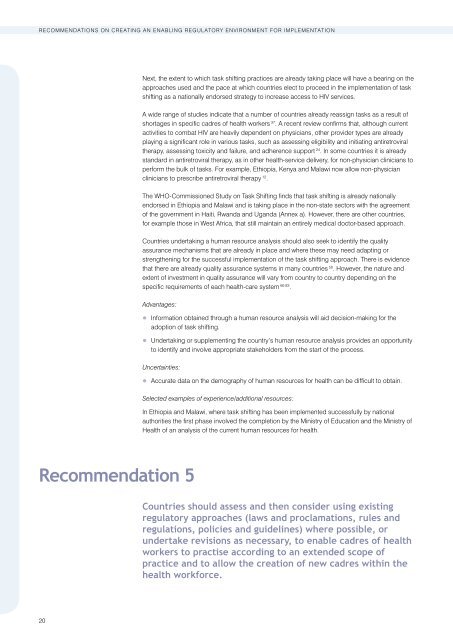Task Shifting - Global Recommendations and Guidelines - unaids
Task Shifting - Global Recommendations and Guidelines - unaids
Task Shifting - Global Recommendations and Guidelines - unaids
You also want an ePaper? Increase the reach of your titles
YUMPU automatically turns print PDFs into web optimized ePapers that Google loves.
<strong>Recommendations</strong> on creating an enabling regulatory environment for implementation<br />
Next, the extent to which task shifting practices are already taking place will have a bearing on the<br />
approaches used <strong>and</strong> the pace at which countries elect to proceed in the implementation of task<br />
shifting as a nationally endorsed strategy to increase access to HIV services.<br />
A wide range of studies indicate that a number of countries already reassign tasks as a result of<br />
shortages in specific cadres of health workers 37 . A recent review confirms that, although current<br />
activities to combat HIV are heavily dependent on physicians, other provider types are already<br />
playing a significant role in various tasks, such as assessing eligibility <strong>and</strong> initiating antiretroviral<br />
therapy, assessing toxicity <strong>and</strong> failure, <strong>and</strong> adherence support 24 . In some countries it is already<br />
st<strong>and</strong>ard in antiretroviral therapy, as in other health-service delivery, for non-physician clinicians to<br />
perform the bulk of tasks. For example, Ethiopia, Kenya <strong>and</strong> Malawi now allow non-physician<br />
clinicians to prescribe antiretroviral therapy 12 .<br />
The WHO-Commissioned Study on <strong>Task</strong> <strong>Shifting</strong> finds that task shifting is already nationally<br />
endorsed in Ethiopia <strong>and</strong> Malawi <strong>and</strong> is taking place in the non-state sectors with the agreement<br />
of the government in Haiti, Rw<strong>and</strong>a <strong>and</strong> Ug<strong>and</strong>a (Annex a). However, there are other countries,<br />
for example those in West Africa, that still maintain an entirely medical doctor-based approach.<br />
Countries undertaking a human resource analysis should also seek to identify the quality<br />
assurance mechanisms that are already in place <strong>and</strong> where these may need adapting or<br />
strengthening for the successful implementation of the task shifting approach. There is evidence<br />
that there are already quality assurance systems in many countries 50 . However, the nature <strong>and</strong><br />
extent of investment in quality assurance will vary from country to country depending on the<br />
specific requirements of each health-care system 66 83 .<br />
Advantages:<br />
• Information obtained through a human resource analysis will aid decision-making for the<br />
adoption of task shifting.<br />
• Undertaking or supplementing the country’s human resource analysis provides an opportunity<br />
to identify <strong>and</strong> involve appropriate stakeholders from the start of the process.<br />
Uncertainties:<br />
• Accurate data on the demography of human resources for health can be difficult to obtain.<br />
Selected examples of experience/additional resources:<br />
In Ethiopia <strong>and</strong> Malawi, where task shifting has been implemented successfully by national<br />
authorities the first phase involved the completion by the Ministry of Education <strong>and</strong> the Ministry of<br />
Health of an analysis of the current human resources for health.<br />
Recommendation 5<br />
Countries should assess <strong>and</strong> then consider using existing<br />
regulatory approaches (laws <strong>and</strong> proclamations, rules <strong>and</strong><br />
regulations, policies <strong>and</strong> guidelines) where possible, or<br />
undertake revisions as necessary, to enable cadres of health<br />
workers to practise according to an extended scope of<br />
practice <strong>and</strong> to allow the creation of new cadres within the<br />
health workforce.<br />
20

















